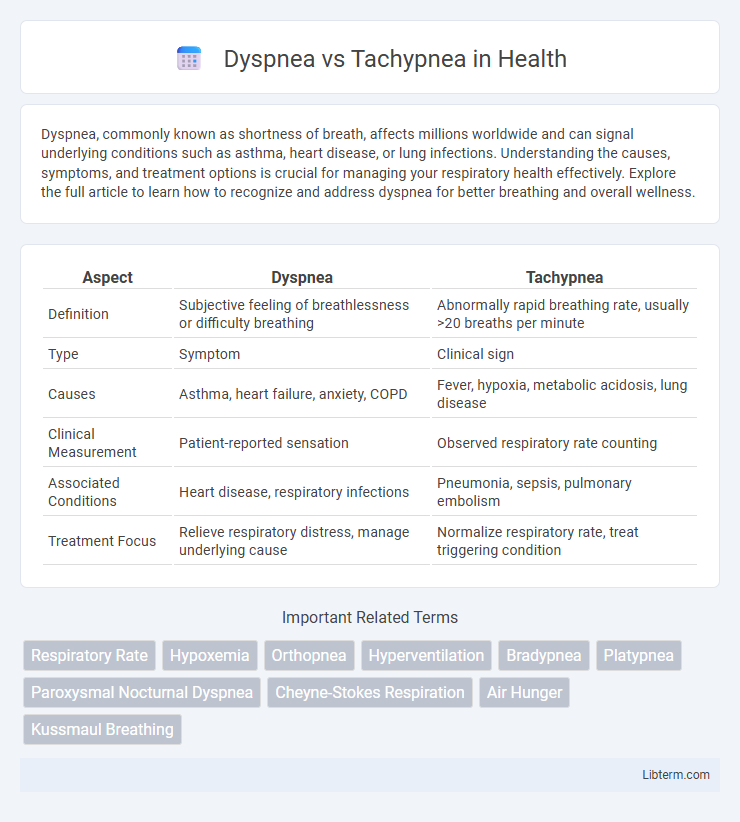Dyspnea, commonly known as shortness of breath, affects millions worldwide and can signal underlying conditions such as asthma, heart disease, or lung infections. Understanding the causes, symptoms, and treatment options is crucial for managing your respiratory health effectively. Explore the full article to learn how to recognize and address dyspnea for better breathing and overall wellness.
Table of Comparison
| Aspect | Dyspnea | Tachypnea |
|---|---|---|
| Definition | Subjective feeling of breathlessness or difficulty breathing | Abnormally rapid breathing rate, usually >20 breaths per minute |
| Type | Symptom | Clinical sign |
| Causes | Asthma, heart failure, anxiety, COPD | Fever, hypoxia, metabolic acidosis, lung disease |
| Clinical Measurement | Patient-reported sensation | Observed respiratory rate counting |
| Associated Conditions | Heart disease, respiratory infections | Pneumonia, sepsis, pulmonary embolism |
| Treatment Focus | Relieve respiratory distress, manage underlying cause | Normalize respiratory rate, treat triggering condition |
Introduction to Dyspnea and Tachypnea
Dyspnea is the subjective sensation of breathlessness or difficulty breathing, often indicating underlying respiratory or cardiac conditions, while tachypnea refers to an abnormally rapid respiratory rate exceeding normal age-specific thresholds, typically over 20 breaths per minute in adults. Dyspnea involves the perception of uncomfortable breathing and can be caused by factors such as asthma, chronic obstructive pulmonary disease (COPD), or heart failure. Tachypnea serves as an objective clinical sign signaling increased respiratory effort or distress, commonly observed in conditions like pneumonia, metabolic acidosis, or pulmonary embolism.
Definition of Dyspnea
Dyspnea is the subjective sensation of difficult or uncomfortable breathing, often described as shortness of breath or breathlessness. It differs from tachypnea, which is an objectively measured increased respiratory rate exceeding 20 breaths per minute in adults. Dyspnea indicates an underlying respiratory or cardiac condition requiring clinical evaluation to identify causes such as asthma, heart failure, or pulmonary embolism.
Definition of Tachypnea
Tachypnea is defined as an abnormally rapid breathing rate, typically exceeding 20 breaths per minute in adults, and is a key clinical indicator of respiratory distress or underlying pathology such as infections, pulmonary embolism, or metabolic acidosis. Unlike dyspnea, which refers to the subjective sensation of breathlessness or difficulty breathing, tachypnea is an objective, measurable increase in respiratory rate. Accurate identification of tachypnea aids in diagnosing acute respiratory conditions and monitoring patient respiratory function.
Key Differences Between Dyspnea and Tachypnea
Dyspnea refers to the subjective sensation of difficult or uncomfortable breathing perceived by the patient, while tachypnea is an objective clinical sign characterized by an abnormally rapid respiratory rate, typically over 20 breaths per minute in adults. Dyspnea involves a psychological and physiological awareness of breathlessness, often associated with conditions like heart failure or chronic obstructive pulmonary disease, whereas tachypnea can result from hypoxia, fever, or metabolic acidosis without necessarily causing the feeling of breathlessness. The key difference lies in dyspnea being a symptom reported by the patient and tachypnea being a measurable physiological parameter observed by healthcare professionals.
Common Causes of Dyspnea
Dyspnea, or shortness of breath, commonly arises from conditions such as chronic obstructive pulmonary disease (COPD), asthma, heart failure, and pulmonary embolism. Unlike tachypnea, which refers specifically to an abnormally rapid breathing rate often caused by fever, anxiety, or metabolic acidosis, dyspnea reflects a subjective sensation of breathing discomfort. Recognizing underlying causes like pneumonia, interstitial lung disease, or anemia is essential for accurate diagnosis and targeted treatment of dyspnea.
Common Causes of Tachypnea
Tachypnea, characterized by an abnormally rapid breathing rate exceeding 20 breaths per minute in adults, is commonly caused by conditions such as fever, anxiety, pulmonary embolism, pneumonia, and chronic obstructive pulmonary disease (COPD). In contrast, dyspnea refers to the subjective sensation of breathlessness or difficulty breathing, which may or may not involve tachypnea. Understanding the various etiologies of tachypnea is essential for accurate diagnosis and effective treatment of respiratory abnormalities.
Clinical Presentation and Symptoms
Dyspnea manifests as a subjective sensation of shortness of breath or difficulty breathing, often reported by patients with conditions like congestive heart failure or chronic obstructive pulmonary disease. Tachypnea is characterized by an abnormally rapid respiratory rate, typically exceeding 20 breaths per minute in adults, and serves as an objective clinical sign observed in cases of respiratory distress, fever, or metabolic acidosis. While dyspnea reflects the patient's perception of breathing discomfort, tachypnea is a measurable physiological response indicating increased respiratory effort or underlying pathology.
Diagnostic Approaches
Dyspnea diagnosis primarily relies on patient history, physical examination, and pulmonary function tests to evaluate breathlessness severity and underlying causes. Tachypnea assessment focuses on measuring respiratory rate, arterial blood gases, and chest imaging to identify abnormalities in respiratory pattern or oxygenation. Both conditions may require pulse oximetry and laboratory tests to differentiate between cardiac, pulmonary, or metabolic etiologies.
Treatment and Management Strategies
Treatment and management strategies for dyspnea focus on addressing the underlying cause, such as heart failure, chronic obstructive pulmonary disease (COPD), or asthma, using medications like bronchodilators, corticosteroids, or diuretics. Tachypnea management involves stabilizing respiratory rate by treating conditions such as pneumonia, metabolic acidosis, or pulmonary embolism through antibiotics, oxygen therapy, or anticoagulants. Both conditions benefit from supportive care including supplemental oxygen, non-invasive ventilation, and lifestyle modifications to improve respiratory function and quality of life.
When to Seek Medical Attention
Seek medical attention for dyspnea if you experience sudden onset, severe shortness of breath, chest pain, or bluish lips, as these symptoms can indicate life-threatening conditions like heart failure or pulmonary embolism. Tachypnea requires prompt evaluation when respiratory rates exceed 30 breaths per minute at rest, accompanied by symptoms such as confusion, fatigue, or cyanosis, signaling possible respiratory distress or infection. Persistent or worsening breathing difficulties, regardless of type, warrant immediate medical assessment to prevent complications and ensure appropriate treatment.
Dyspnea Infographic

 libterm.com
libterm.com